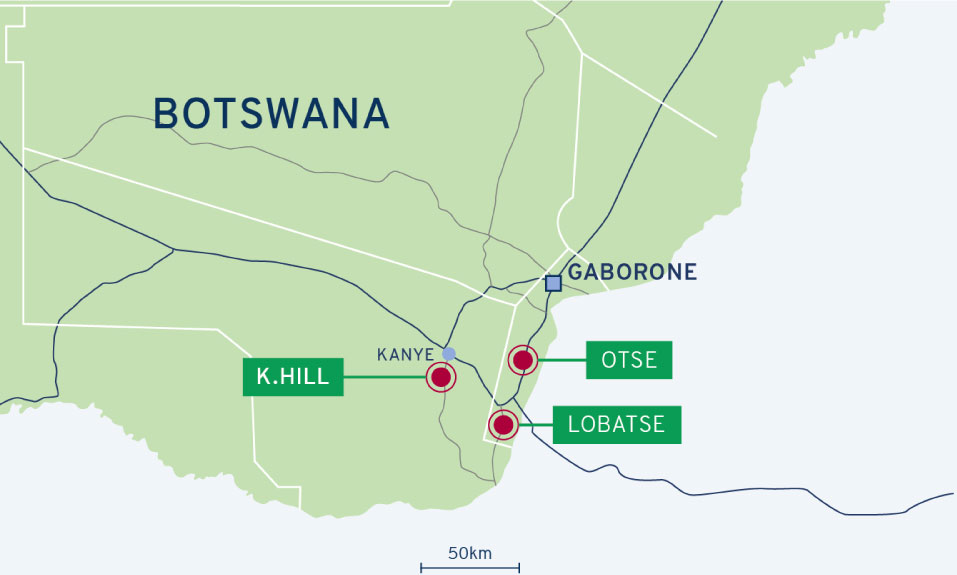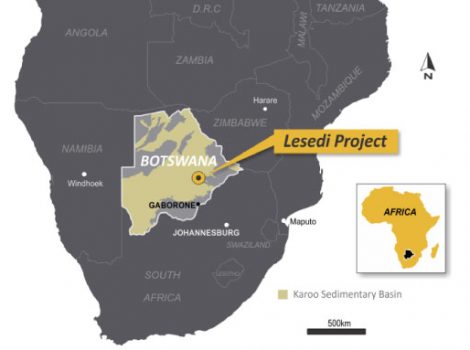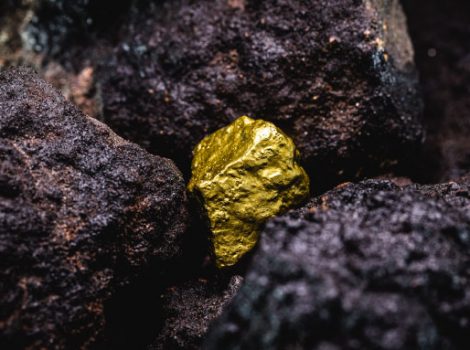Project type: Manganese project
Mining Type: Open pit
Location: South Eastern Botswana
Expected life of mine: 11 years
Probable reserves: 2mt of manganese oxide
Total life of mine capital expenditure (including contingency): $307m
Expected annual production: 73kt per annum of high-purity manganese sulphate monohydrate (HPMSM)
Owner: Giyani Metals (100%)
Kgwakgwe Hill (K.Hill) is a battery-grade manganese project being developed near the town of Kanye in south-eastern Botswana. The project, owned by Giyani Metals, will involve producing high-purity sulphate monohydrate (HPMSM) from manganese oxide. The results of the feasibility study for the K.Hill project were published in November 2022. The study highlighted a post-tax net present value of $481m after tax and a post-tax internal rate of return of 28%.
K.Hill is also expected to generate a net free cashflow of $1.09bn over the life of the project. The total mine life capital expenditure including contingency is estimated to be $307m. It is expected to begin commercial production in 2025 and have a mine life of 11 years. The battery-grade manganese project will produce 73 kilo tonnes (kt) per annum of HPMSM at an average ore grade of 18.9% manganese oxide (MnO).
Location and Site details
K.Hill is located near the town of Kanye, the administrative centre of the Southern District of the Republic of Botswana. The site can be accessed by a short section of unpaved roads and tracks from A1 and A2 national roads. According to a mineral resource estimate published in 2022, the project is located within Prospecting Licence No. 322/2016 encompassing a prospecting area of 878km2. In the Kanye area, mining activities were conducted from 1957 to 1971.
Marble Lime and Associated Industries was the first company which operated at Kgwakgwe Hill and mined mostly manganiferous shale. It stopped operations around 1967. Rand London Manganese investigated for mining manganiferous shale at Kgwakgwe, Otse, and Gopane (near Lobatse) together in 1981. The Kgwakgwe deposit required further drilling, but no work was undertaken further and the licence was relinquished within one year.
Geology and Mineralisation
At K.Hill, the manganese mineralisation occurs primarily as a supergene enriched manganiferous shale hosted in two distinct horizons in the upper portion of a larger package of shale within the Black Reef Quartzite Formation of the Transvaal Supergroup. A hard chert breccia unit lies above manganiferous shale horizons. The mineralised horizons consist of two main parts- the Upper Mn-Shale Horizon A and the Lower Mn-Shale Horizon B.
The two horizons are expected to be continuous stratiform bodies, however, recent studies indicate that the whole shale package has probably been deformed by post mineralisation thrusting to form a stacked series of duplex folds and faults. A minor third part – Lower Mn-Shale Horizon C, shows similar dips. The Horizon A contains highest grade manganese oxide (MnO) mineralisation with thickness ranging from 2m to 15m in thickness. The Horizon B has an average thickness of 3.5m without distinct banding of grade. The two horizons are separated by shale waste rock of approximately 4m.
Mineral Reserves
In October 2022, the mineral reserves for the project were estimated to be 2,032kt of ore with 18.9% MnO at a cut-off grade of 7.3% MnO in the probable reserve category. MnO contained metal stands at 384kt. The mineral reserve is a subset of the Indicated Resource.
An updated mineral resource estimate for K.Hill was published in February 2022. Probable mineral reserves have been modified from indicated resources only, considering the absence of measured resources. The remaining inferred resource of 3.1Mt for the project is under assessment to be upgraded into the indicated resource category.
The new mineral resource estimates for K.Hill and the nearby Otse manganese oxide prospect are expected to be completed in the first half of 2023.
Mining
Giyani Metals will employ open pit, free-digging mining at K.Hill battery-grade manganese project. The ore will be extracted by conventional truck-and-shovel mining method.
According to the mining plan, the ore will be mined in a three-zone cutback sequence starting from the upper section of the southern flank of the pit.
The mined ore will be sent to either the plant, the stockpile, or the waste rock dump (WRD).
Backhoe excavators will be used to load selectively into 30tonne haul trucks.
The plan aims 8.5 years of mining and an additional 2.5 years of stockpile rehandling and processing, providing it with a total operational LOP of around 11 years.
Processing of ore
The process plant will be equipped to treat 200 kt per annum of RoM ore from the open pit. It would have a nameplate production capacity of up to 120kt/a HPMSM crystals. At first, the ore will be crushed and milled into a slurry comprising mainly manganese and iron shales. It is subjected to acid leaching in sulphate media using sulphur dioxide as a reductant.
The sequential precipitation and solid/liquid separation steps will systematically remove metal impurities from the leachate to produce a purified solution. Fluoride polishing further removes trace contaminants. The HPMSM will be crystallised from the stock solution. The final product will be in the form of dried HPMSM crystals that will be packed and transported in sealed bulk bags. A feasibility level metallurgical test work programme was carried out at Mintek, a mineral processing and metallurgical research laboratory in Johannesburg, South Africa.
Standard crushing and grinding test work and additional test work were designed to characterise the leach and selective precipitation behaviour of ore sample. Laboratory and test work showed that HPMSM of not less than 99.97% purity can be produced. The HPMSM crystals will also meet the requirements of international buyers.
Infrastructure
Other project infrastructure will include a network of paved national and local roads, tailings management facility and gatehouse (consisting of a four-bay truck parking area, a guard house, two weight bridges, control room, and site gate). It will also feature light steel industrial warehouse, mechanical/electrical workshop, truck shop and bagging plant among others. The Botswana Power Corporation (BPC) will provide power supply infrastructure for the project.
The infrastructure will include a 132/33 kV substation, a new 19km long 132kV transmission line from the Mmakgodumo substation and a new 132/11 kV substation within the vicinity of the K.Hill site. It will support a total load demand of up to 30MVA and will enable in accommodating a future potential expansion project. A 4.5MWdc solar plant will also be established to reduce energy taken from national grid and reduce carbon emission footprint.
Contractors
On 13 December 2019, Giyani Metals awarded the feasibility study contract to SRK Consulting, Tetra Tech, and Royal IHC for K.Hill manganese project. SRK Consulting prepared the feasibility study and lead the geotechnical study in Cardiff, the UK. Minviro Limited prepared the life cycle assessment (LCA) based on the feasibility study of the K.Hill project. Loci Environmental Management and Consulting (Loci) won the Environmental Assessment contract for the project in 9 January 2020.
Stewardship Drilling carried out infill drilling at K.Hill, while Tetra Tech was appointed for conducting solar plant study. On 2 September 2021, RotsDill Explorations was appointed as the additional drilling contractor to assist Stewardship Drilling for the infill drilling programme.
In January 2021, Giyani Metals also appointed Tetra Tech for concept design of a demonstration plant of the project. South African-based hydrometallurgical engineering firm Met63 was awarded the design-build contract for the construction of a demonstration plant. Coffey Geotechnics, a Tetra Tech company, prepared the design of the process flowsheet for K.Hill Project.
Source: https://www.nsenergybusiness.com/projects/k-hill-battery-grade-manganese-project/




